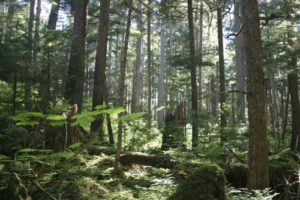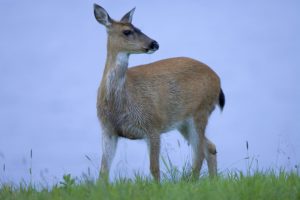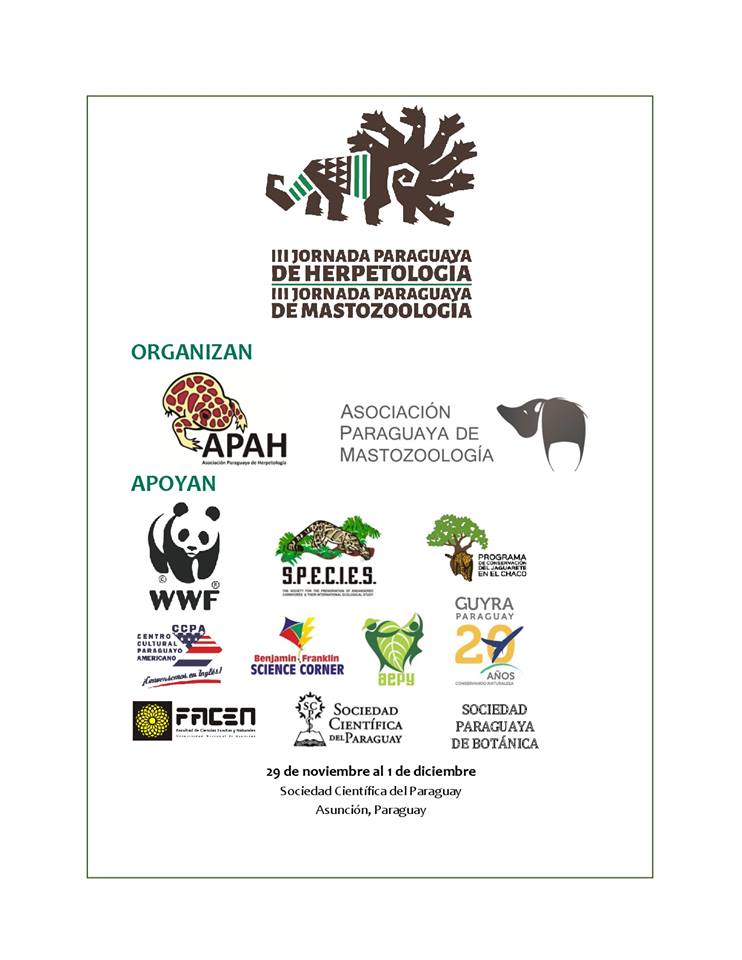The Alexander Archipelago wolf (Canis lupus ligoni), also known as the Island Wolf, is one of the rarest wolf subspecies in the world. Endemic to southeastern Alaska, it has been isolated from other North American wolves for millennia, and is both morphologically and genetically distinct. It is smaller and darker than other wolves, and it comprises a significant portion of grey wolf (C. lupus) genetic diversity in North America.

The Alexander Archipelago wolf is also behaviorally and ecologically distinct from other wolf populations. For instance, this subspecies is unique in its habit of feeding nearly entirely on a single species, the Sitka black-tailed deer. Both the Alexander Archipelago wolf and the deer depend on old-growth forests for survival. In particular, the Tongass National Forest, the nation’s largest national forest, is crucial habitat for the wolf and the Sitka black-tailed deer. It is home to some of the largest remaining stands of old-growth, temperate rainforest in the world, as well as other endemic species like the Prince of Wales Island flying squirrel (Glaucomys sabrinus griseifrons) and a distinct lineage of Mustela ermine that depend on these old-growth stands.
However, recent increases in logging pose a major threat to the Tongass National Forest and the wildlife within. Reduction of old-growth forest diminishes crucial winter habitat for the Sitka black-tailed deer, leading to declines of the wolf’s most important prey. The impact of the timber projects, combined with the past 60 years of logging, is increasing the deer’s susceptibility to predation, hunting, and weather. Furthermore, high density of logging roads provides increased human access, which is directly related to high wolf mortality and illegal take of wolves.

Sitka black-tailed deer
In particular, the 2014 Big Thorne timber sale by the U.S. Forest Service has paved the way for the largest logging operation in the Tongass Forest in 20 years. This project allows for over 148 million board feet of timber to be logged from 8,500 acres of old-growth forest. Furthermore, in July 2017, the USFS put forth a proposal for the POW LLA Project that would consist of an additional 200 million board feet of logging of old-growth forest on Prince of Wales Island.
The population of the Alexander Archipelago wolf residing on Prince of Wales Island is particularly threatened. Making up potentially 30% of the wolves in southeast Alaska, these wolves are bo th geographically and genetically isolated from other populations, and constitute one of the most at-risk populations of the subspecies. Since the mid-1990s, the population of Alexander Archipelago wolves on Prince of Wales Island has declined from about 250-350 down to an estimated 89 individuals. This population is therefore of crucial conservation interest.
th geographically and genetically isolated from other populations, and constitute one of the most at-risk populations of the subspecies. Since the mid-1990s, the population of Alexander Archipelago wolves on Prince of Wales Island has declined from about 250-350 down to an estimated 89 individuals. This population is therefore of crucial conservation interest.
Despite these risks, the Alexander Archipelago wolf and the Prince of Wales Island population have been repeatedly denied endangered or threatened status under the Endangered Species Act since 1993. As a result, populations of the subspecies have substantially declined since the mid-1990s under the continued pressure of logging, unsustainable harvesting, and increased human access via roads. And despite a recent suit, the courts have upheld the U.S. Forest Service’s Big Thorne timber sale, putting at risk not just the wolf, but the numerous other endemic and unique species that reside in southeastern Alaska. We must act now to save the Alexander Archipelago wolf and its vanishing habitat.
.
Programa de Conservación del Jaguarete en el Chaco presents at the Green Expo 2017
/in Activities & Events /by Stefanie SillerUnder the motto “For a more sustainable education”, the third edition of the Green Expo was held on 4 and 5 October in the city of Luque, Paraguay. S.P.E.C.I.E.S.’s Programa de Conservación del Jaguarete en el Chaco presented a stand along with several other environmentally-focused organizations and institutions. The event was organized by Green Tour Magazine and Rakiura Resort day.
During the event, the S.P.E.C.I.E.S. team was able to share with students, teachers, communicators, colleagues and friends what they are most passionate about: the conservation of the jaguarete.
Diego Gustavo Giménez, the Chief Program Officer for the Chaco Jaguar Conservation Project in Paraguay, also gave a talk discussing the current situation of the jaguar, as well as explaining what the Program is, how it works, and how people can help. The team was also able to talk to several media outlets who were interested in spreading the word about the jaguar and S.P.E.C.I.E.S..
The Expo featured presentations from companies, public and private institutions, and artists, who demonstrated through talks, dance, and other interactive activities what they are doing in pursuit of the environment and nature.
S.P.E.C.I.E.S. Presents at Cal Poly
/in Activities & Events /by Stefanie SillerOn December 1st, Anthony Giordano, founder and director of S.P.E.C.I.E.S., presented on the Conservation Status of the Jaguar (Panthera onca) in the Dry Chaco and Paraguay at the California Polytechnic State University Biological Sciences Department Seminar. This work is part of the Chaco Jaguar Conservation Project, the only long-term transboundary conservation project committed to resolving human-jaguar conflict, ecological investigations and surveys of jaguars, and jaguar conservation planning and strategy implementation, in the Gran Chaco.
Read more about the Chaco Jaguar Conservation Project here.
S.P.E.C.I.E.S. Supports the III Paraguayan Workshop on Herpetology and Mastozoology
/in Activities & Events /by Stefanie SillerThe III Paraguayan Workshop on Herpetology and Mastozoology was held in Asunción, Paraguay on November 29 and 30 and December 1 at the Scientific Society of Paraguay. It brought together professionals who are dedicated to the study, scientific research and conservation of mammals, amphibians and reptiles, and featured a variety of different workshops and courses.
The event was supported by S.P.E.C.I.E.S. and the Chaco Jaguar Conservation Project, demonstrating the special interest that S.P.E.C.I.E.S. has towards the development and strengthening of science in Paraguay.
The event had three main objectives:
1. Disseminate knowledge about mammals, amphibians and reptiles in particular from Paraguay and the neotropical region, as well as their ecosystemic roles, in different sectors of society.
2. Encourage and collaborate in the development and theoretical and practical training of interdisciplinary professionals and young researchers in the country.
3. Encourage and promote joint work in interdisciplinary institutions and individuals interested in the study and conservation of mammals, amphibians and reptiles at the national and regional levels.
S.P.E.C.I.E.S. Programa de Conservación del Jaguarete en el Chaco presents on the recent update to the IUCN Red List for Paraguay
These conferences are of great importance for science in Paraguay because they allow professionals in this area to learn and get up to date with the work on mammals, amphibians and reptiles that is being done in Paraguay and the region. In addition, it offers a guide to students on careers related to these subjects and specialties, giving them the opportunity to learn about mammalogy and herpetology and providing direction for their futures.
El Programa de Conservación del Jaguarete en el Chaco Featured on La Aventura de Descubrir
/in Activities & Events /by Stefanie SillerThis fall, El Programa de Conservación del Jaguarete en el Chaco (The Chaco Jaguar Conservation Program) was featured on the radio program La Aventura de Descubrir.
Listen to the recording below!
Be sure to connect with El Programa de Conservación del Jaguarete!
“Cats in the Shadow” Panel at the Jackson Hole Festival & Summit
/in Activities & Events /by Stefanie SillerEarlier this fall, SPECIES attended the Jackson Hole Festival & Summit, where over 650 media professionals came together to celebrate the union of wildlife and film. This year, the festival’s focus was on the world’s wild cats, as advocates, researchers, and the media industry joined together in the goal to conserve wild cats and their habitats.
SPECIES founder and director Anthony Giordano brought his knowledge and expertise to the “Cats in the Shadows” panel, which highlighted stories from the world of small and rare cat conservation and research.
Anthony Giordano presents on clouded leopards during the “Cats in the Shadows” panel
Anthony Giordano speaking to cinematographer Derek Joubert
Cats of the Canopy
/in SPECIES in the news /by Stefanie SillerAs the smallest of the big cats, clouded leopards have fallen through the cracks of mainstream conservation efforts. Because they have been overshadowed by other charismatic Asian megafauna, very little is known about their status on local or even regional scales. However, it is precisely their unique ecological and evolutionary characteristics that make clouded leopards a potential flagship species, and is why they represent S.P.E.C.I.E.S. as our logo. In fact, the clouded leopard may possibly be related to the saber-tooth cat!
S.P.E.C.I.E.S. is working to not only collect important baseline information on the 2 species of clouded leopards, but also to inform the general public about the clouded leopard. In particular, S.P.E.C.I.E.S. aims to publicize the major threat facing clouded leopards today: oil palm displacement of natural habitats. By donating to projects like Project Neofelis or Cameras4Conservation, people can help support clouded leopard conservation.
To learn more about the clouded leopard and S.P.E.C.I.E.S. efforts to conserve this unique species, read the latest article at Purr and Roar here.
Can Taiwan’s Formosan clouded leopard claw its way back from extinction?
/in SPECIES in the news /by Stefanie SillerToday, 2 species of clouded leopard roam throughout Asia: Neofelis nebulosa (clouded leopard), and Neofelis diardi (the Sunda clouded leopard). These species are rarely glimpsed in the wild, and are now at risk of extinction. Indeed, only 4 years ago, a third type of clouded leopard, Neofelis nebulosa brachyura (the Formosan clouded leopard), was declared extinct from its home in Taiwan. However, questions remain as to whether the Formosan clouded leopard ever existed at all.
No clouded leopard has been seen in Taiwan for decades. For 16 years, camera traps and snares were set up to try and capture evidence of their existence, but not a single leopard was found. Still, most biologists believe the Formosan clouded leopard existed as a subspecies or subpopulation of N. nebulosa.
Now, conservationists hope to return the clouded leopard to the island of Taiwan. Taiwan has suitable habitat to support clouded leopard populations, and S.P.E.C.I.E.S. is working to determine how locals would feel about this reintroduction.
To learn more about this unusual extinction story, read Post Magazine’s article here.
A little cat goes a long way
/in SPECIES in the news /by Stefanie SillerJaguarundis have the second-greatest north-south distribution of any wild cat in the Americas. They have historically been known to range from Argentina all the way to Arizona. However, as no one has ever photographed a wild jaguarundi in Arizona, the question remains – are they actually there?
“The jaguarundi, for me, represents a big mystery,” says Giordano. “In some areas, they’re more like ghosts.” Although it has been assumed that they are common and widespread in certain areas, basic information on where they live is incomplete. In Arizona, for instance, jaguarundis are frequently identified, but no evidence has been shown of their existence in the state.
Read more about the hunt for the jaguarundi in Arizona, featuring S.P.E.C.I.E.S. founder and director Anthony Giordano, below:
A little cat goes a long way
A clouded future: Asia’s enigmatic clouded leopard threatened by palm oil
/in SPECIES in the news /by Stefanie SillerThe clouded leopard is so elusive that we didn’t know there were two species of this cat until 2006. Its elusiveness has made conservation efforts very difficult. Although both species are listed as “Vulnerable” by the IUCN, we know very little about their behavior or ecology. Because of this, they have been largely overlooked by both conservationists and the public.
It is known, however, that palm oil production is greatly affecting the clouded leopard. The clouded leopard’s habitat lies within three of the world’s top palm oil producing nations: Malaysia, Indonesia, and Thailand. Palm oil production is destroying the natural habitat of this small big cat, and it is difficult to know how the cat will adapt to these huge changes. Along with palm oil, poaching, trapping, and a decline in prey have also negatively affected the clouded leopard.
Read more about the different challenges, solutions, and future predictions that palm oil production will have on the clouded leopard in Mongabay’s recent article, featuring S.P.E.C.I.E.S. director and founder Anthony Giordano, here.
The Alexander Archipelago Wolf
/in Meet The Carnivores /by Stefanie SillerThe Alexander Archipelago wolf (Canis lupus ligoni), also known as the Island Wolf, is one of the rarest wolf subspecies in the world. Endemic to southeastern Alaska, it has been isolated from other North American wolves for millennia, and is both morphologically and genetically distinct. It is smaller and darker than other wolves, and it comprises a significant portion of grey wolf (C. lupus) genetic diversity in North America.
The Alexander Archipelago wolf is also behaviorally and ecologically distinct from other wolf populations. For instance, this subspecies is unique in its habit of feeding nearly entirely on a single species, the Sitka black-tailed deer. Both the Alexander Archipelago wolf and the deer depend on old-growth forests for survival. In particular, the Tongass National Forest, the nation’s largest national forest, is crucial habitat for the wolf and the Sitka black-tailed deer. It is home to some of the largest remaining stands of old-growth, temperate rainforest in the world, as well as other endemic species like the Prince of Wales Island flying squirrel (Glaucomys sabrinus griseifrons) and a distinct lineage of Mustela ermine that depend on these old-growth stands.
However, recent increases in logging pose a major threat to the Tongass National Forest and the wildlife within. Reduction of old-growth forest diminishes crucial winter habitat for the Sitka black-tailed deer, leading to declines of the wolf’s most important prey. The impact of the timber projects, combined with the past 60 years of logging, is increasing the deer’s susceptibility to predation, hunting, and weather. Furthermore, high density of logging roads provides increased human access, which is directly related to high wolf mortality and illegal take of wolves.
Sitka black-tailed deer
In particular, the 2014 Big Thorne timber sale by the U.S. Forest Service has paved the way for the largest logging operation in the Tongass Forest in 20 years. This project allows for over 148 million board feet of timber to be logged from 8,500 acres of old-growth forest. Furthermore, in July 2017, the USFS put forth a proposal for the POW LLA Project that would consist of an additional 200 million board feet of logging of old-growth forest on Prince of Wales Island.
The population of the Alexander Archipelago wolf residing on Prince of Wales Island is particularly threatened. Making up potentially 30% of the wolves in southeast Alaska, these wolves are bo th geographically and genetically isolated from other populations, and constitute one of the most at-risk populations of the subspecies. Since the mid-1990s, the population of Alexander Archipelago wolves on Prince of Wales Island has declined from about 250-350 down to an estimated 89 individuals. This population is therefore of crucial conservation interest.
th geographically and genetically isolated from other populations, and constitute one of the most at-risk populations of the subspecies. Since the mid-1990s, the population of Alexander Archipelago wolves on Prince of Wales Island has declined from about 250-350 down to an estimated 89 individuals. This population is therefore of crucial conservation interest.
Despite these risks, the Alexander Archipelago wolf and the Prince of Wales Island population have been repeatedly denied endangered or threatened status under the Endangered Species Act since 1993. As a result, populations of the subspecies have substantially declined since the mid-1990s under the continued pressure of logging, unsustainable harvesting, and increased human access via roads. And despite a recent suit, the courts have upheld the U.S. Forest Service’s Big Thorne timber sale, putting at risk not just the wolf, but the numerous other endemic and unique species that reside in southeastern Alaska. We must act now to save the Alexander Archipelago wolf and its vanishing habitat.
.